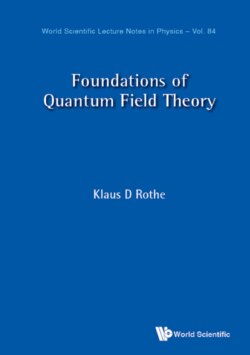Читать книгу Foundations of Quantum Field Theory - Klaus D Rothe - Страница 9
На сайте Литреса книга снята с продажи.
ОглавлениеChapter 1
The Principles of Quantum Physics
Quantum Field Theory is a natural outgrowth of non-relativistic Quantum Mechanics, combining it with the Principles of Special Relativity and particle production at sufficiently high energies. We therefore devote this introductory chapter to recalling some of the basic principles of Quantum Mechanics which are either shared or not shared with Quantum Field Theory.
1.1Principles shared by QM and QFT
We briefly review first the principles which non-relativistic Quantum Mechanics (NRQM), relativistic Quantum Mechanics (RQM) and Quantum Field Theory (QFT) have in common.
(1)Physical states
Physical states live in a Hilbert space phys and are denoted by |Ψ.
(2)Time development
In the Schrödinger picture, operators OS are independent of time and physical states |Ψ(t) obey the equation,
with H the Hamiltonian.
In the Heisenberg picture physical states |ΨH are independent of time and operators O(t)H obey the Heisenberg equation
The states in the two pictures are related by the unitary transformation
(3)Completeness
Eigenstates |Ψn > of H,
are assumed to satisfy the completeness relation
with n standing for a discrete or continuous label.
(4)Observables
To every observable corresponds a hermitian operator; however, not every hermitian operator corresponds to an observable.
(5)Symmetries
Symmetry transformations are represented in the Hilbert space by unitary (or anti-unitary) operators.
(6)Vector space
The complete system of normalizable states |Ψ ∈ defines a linear vector space.
(7)Covariance of equations of motion:
If and ′ denote two inertial reference frames, then covariance means that the equation
implies
Furthermore, there exists a unitary operator U which realizes the transformation → ′:
(8)Physical states
All physical states can be gauged to have positive energy1
(9)Space and time translations
Space-time translations are realized on |Ψ respectively by2
where is the momentum operator, and rotations are realized on |Ψ by
with the generator of rotations
1.2Principles of NRQM not shared by QFT
The following principles of non-relativistic quantum mechanics must be abandoned in the case of QFT:
(1)Probability amplitude
In NRQM we associate with the state |Ψ(t) a wave function
then represent the probability of finding a particle in the interval at time t. (Notice the treatment of space and time on unequal footing.) In QFT we can have particle production, that is, we are dealing with “many-particle” physics. Hence notions linked to a one particle picture must be abandoned in the relativistic case.
(2)Galilei transformations
For a scalar function and a Galilei transformation , t′ = t we must have
Consider in particular a plane wave in S as seen by an observer in S′ moving with a velocity with respect to S:
where
We have
with
We seek an operator with the property
From
and
we conclude, by comparing with (1.1),
where is the position operator. Now
Hence we may write in the form
where we have used
Denoting by the eigenstates of the momentum operator
we have
For the solution
of the “free” Schrödinger equation we obtain from (1.3),
or
Furthermore, making use of
we have
or
with
Correspondingly we have from (1.7)
in accordance with expectations.
(3)Covariance of equations of motion
From
follows
which we rewrite as
Noting from (1.3) and (1.2) that
we obtain, using (1.6),
or, recalling (1.7),
This equation expresses on operator level the covariance of the free-particle equation of motion: If is a solution of the equations of motion, then is also a solution.
Group-property
As Eq. (1.4) shows, a Galilei transformation is represented by the unitary operator
with
the generators of boosts. We have
so that different “boosts” commute with each other. The Galilei transformations thus correspond to an abelian Lie group. In particular
Boosts
Let S and S′ be two inertial frames whose clocks are synchronized in such a way, that their respective origins coincide at time t = 0. Then we have for an eigenstate of the momentum operator, as seen by observers O and O′ in S and S′
respectively. In particular, for a particle at rest in system S we obtain, from the point of view of O′,
Define
where stands for a Galilei transformation taking and . U[B()] is thus an operator which takes a particle at rest into a particle with momentum . One refers to this as a “boost” (active point of view).
We have the following property of Galilei transformations not shared by Lorentz transformations (compare with (2.23)): boosts and rotations separately form a group. Indeed one easily checks that
(4)Causality
We next want to show that NRQM violates the principle of causality. We have for any interacting theory,
Let |En be a complete set of eigenstates of H:3
Then
Define
as well as
The kernel satisfies a heat-like equation:
In terms of this kernel we have from above,
We now specialize to the case of a free point-like particle. In that case
and correspondingly we have with (1.8),
Notice that the kernel K0 satisfies the desired initial condition (1.9).
From (1.10), for the initial condition , we get
or in particular
that is, for an infinitesimal time after t0 one already finds the particle with equal probability anywhere in space; this violates obviously the principle of relativity, as well as causality.
________________________
1In a relativistic theory, can also contain negative energy states, which then require a particular interpretation or must decouple altogether from the “physical sector” of the theory.
2In Quantum Mechanics
In this chapter we use everywhere lower indices, repeated indices being summed over.
3For notational simplicity we suppose the spectrum to be discrete.
